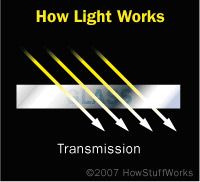Ever watch a house being built? Carpenters first erect the basic skeleton of the structure using two-by-four studs. Then they nail sheathing, usually plywood, to the studs to make walls. Most walls include a window opening, which holds a sheet of glass situated within a frame. Windows make a home feel bright, warm and welcoming because they let light enter. But why should a glass window be any more transparent than the wood that surrounds it? After all, both materials are solid, and both keep out rain, snow and wind. Yet wood is opaque and blocks light completely, while glass is transparent and lets sunshine stream through unimpeded.
You may have heard some people — even some science textbooks — try to explain this by saying that wood is a true solid and that glass is a highly viscous liquid. They then go on to argue that the atoms in glass are spread farther apart and that these gaps let light squeeze through. They may even point to the windows of centuries-old houses, which often look wavy and unevenly thick, as evidence that the windows have "flowed" over the years like the slow crawl of molasses on a cold day.
Advertisement
In reality, glass isn't a liquid at all. It's a special kind of solid known as an amorphous solid. This is a state of matter in which the atoms and molecules are locked into place, but instead of forming neat, orderly crystals, they arrange themselves randomly. As a result, glasses are mechanically rigid like solids, yet have the disordered arrangement of molecules like liquids. Amorphous solids form when a solid substance is melted at high temperatures and then cooled rapidly — a process known as quenching.
In many ways, glasses are like ceramics and have all of their properties: durability, strength and brittleness, high electrical and thermal resistance, and lack of chemical reactivity. Oxide glass, like the commercial glass you find in sheet and plate glass, containers and light bulbs, has another important property: It's transparent to a range of wavelengths known as visible light. To understand why, we must take a closer look at the atomic structure of glass and understand what happens when photons — the smallest particles of light — interact with that structure.
We'll do that next.
Advertisement




